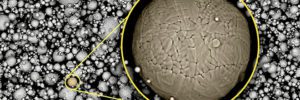
Martensitic steels—materials that are both corrosion-resistant and hardenable via heat treating to a wide range of hardness and strength levels—lend themselves to applications in the aerospace, automotive and defense industries, in which high-strength, lightweight parts need to be manufactured inexpensively. Researchers from Texas A&M University, in collaboration with scientists at the Air Force Research Laboratory, have now developed guidelines that allow 3D printing of martensitic steels into sturdy, defect-free objects of nearly any shape.
“Strong and tough steels have tremendous applications, but the strongest ones are usually expensive—the one exception being martensitic steels that are relatively inexpensive, costing less than a dollar per pound,” said Professor Ibrahim Karaman, head of the Department of Materials Science and Engineering. “We have developed a framework so that 3D printing of these hard steels is possible into any desired geometry and the final object will be virtually defect-free.”
Although the procedure developed was initially for martensitic steels, the researchers say they’ve made their guidelines general enough that the same 3D-printing pipeline can be used to build intricate objects from other metals and alloys as well. The findings of the study were reported in the December issue of the journal Acta Materialia.
To have diverse applications, martensitic steels, particularly a type called low-alloy martensitic steels, need to be assembled into objects of different shapes and sizes to suit a particular application. 3D printing provides a practical solution, as complex items can be built layer by layer by heating and melting a single layer of metal powder with a laser. Stacking these layers creates the final 3D-printed object.
However, 3D printing martensitic steels using lasers can introduce unintended defects in the form of pores within the material.
“Porosities are tiny holes that can sharply reduce the strength of the final 3D-printed object, even if the raw material used for the 3D printing is very strong,” Karaman said. “To find practical applications for the new martensitic steel, we needed to go back to the drawing board and investigate which laser settings could prevent these defects.”
For their experiments, the team first chose an existing mathematical model inspired by welding to predict how a single layer of martensitic steel powder would melt for different settings for laser speed and power. By comparing the type and number of defects they observed in a single track of melted powder with the model’s predictions, they were able to change their existing framework slightly so that subsequent predictions improved.
After a few such iterations, their framework could correctly forecast, without needing additional experiments, if a new, untested set of laser settings would lead to defects in the martensitic steel. The researchers said this procedure is more time-efficient.
“Testing the entire range of laser setting possibilities to evaluate which ones may lead to defects is extremely time-consuming, and at times, even impractical,” said Raiyan Seede, a graduate student in the College of Engineering and the primary author of the study. “By combining experiments and modeling, we were able to develop a simple, quick, step-by-step procedure that can be used to determine which setting would work best for 3D printing of martensitic steels.”
Source: Texas A&M University
Image: Raiyan Seede, Microstructural Engineering of Structural and Active Materials Group
source https://chargedevs.com/newswire/texas-am-researchers-develop-a-method-for-3d-printing-hard-steels/
No comments:
Post a Comment